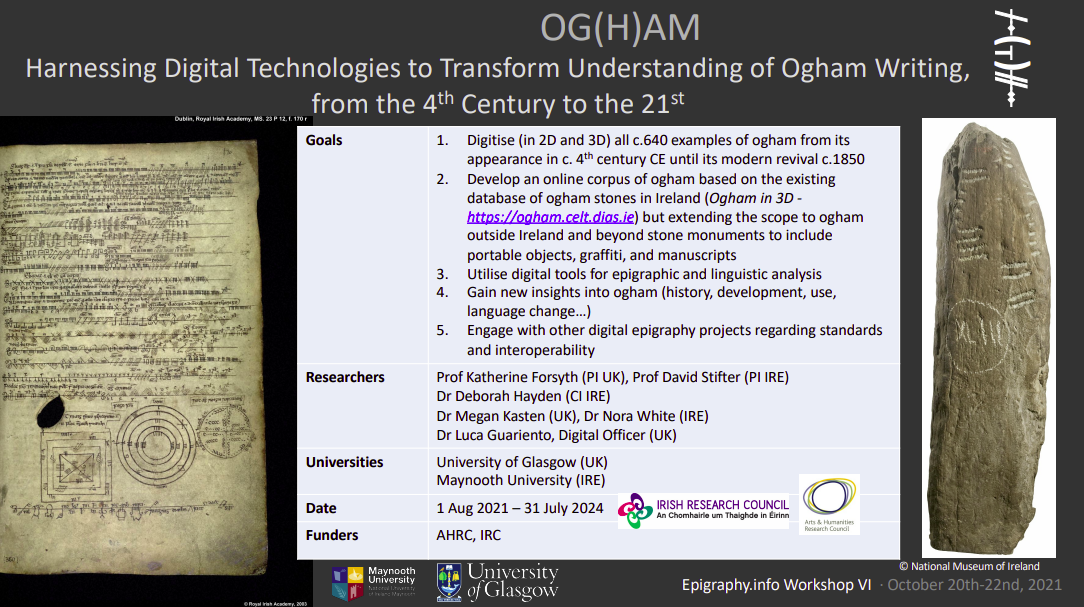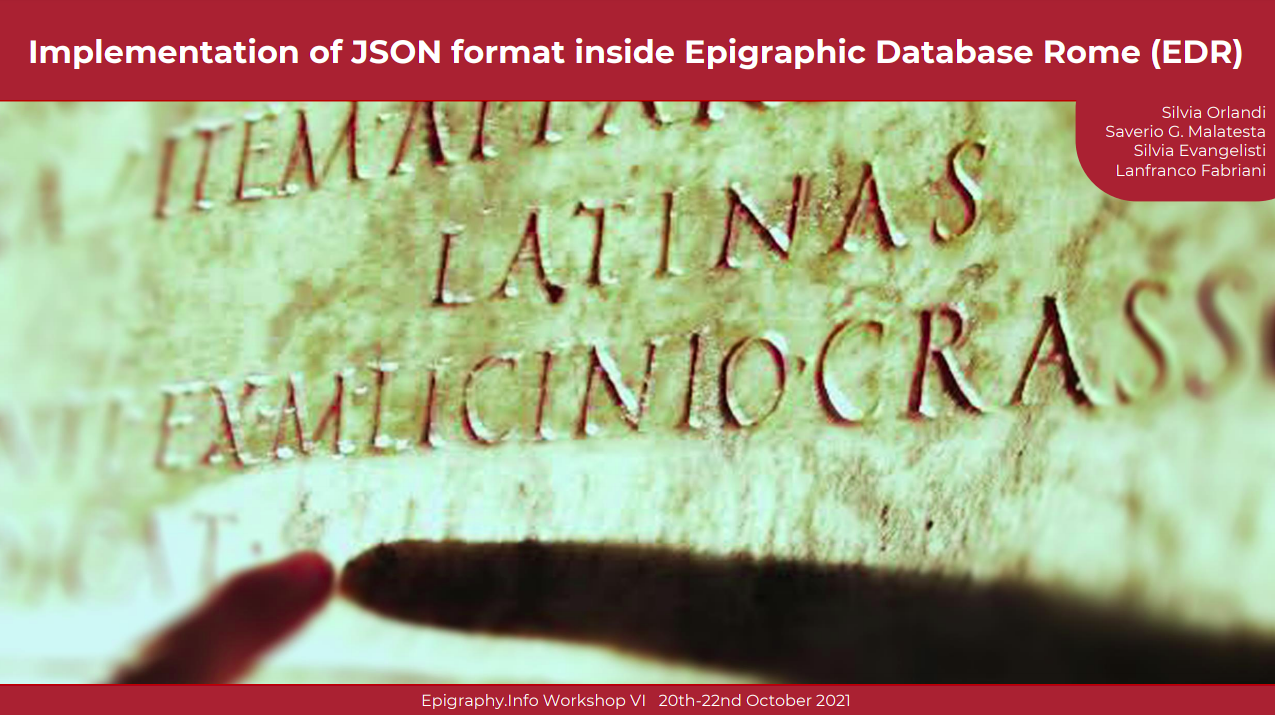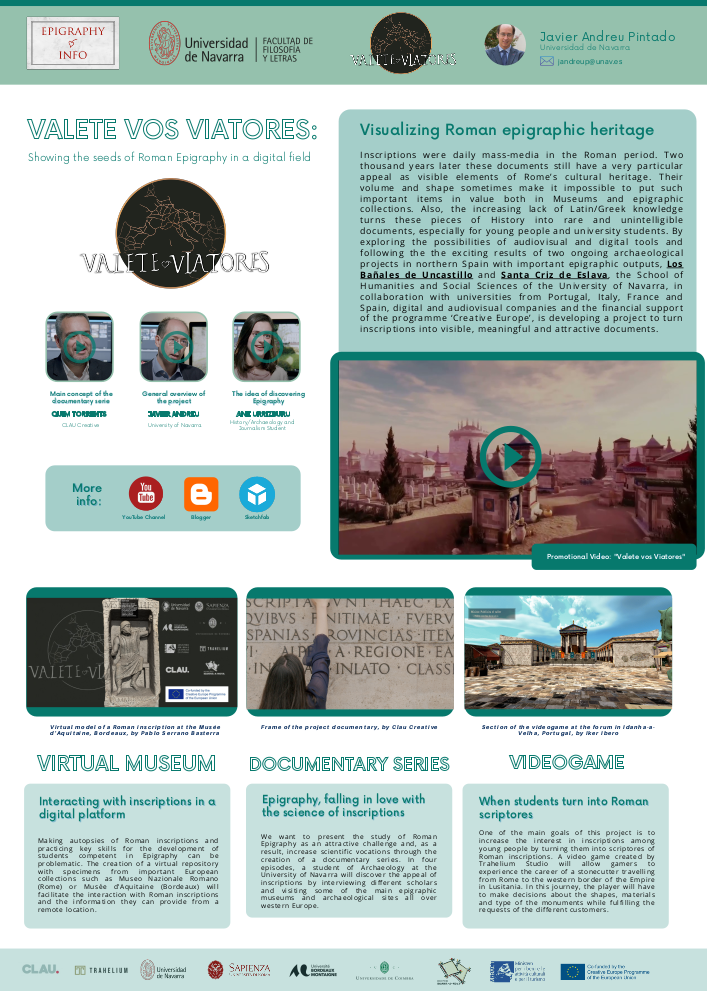Workshop 6 posters
Thursday, October 21, 13:30 - 14:30
The sixth workshop will host an E-poster session dedicated to the presentation of new and ongoing projects in the field of Digital Epigraphy. There will be a portion of the workshop dedicated to presentation of the posters and breakout room discussion. The E-posters will be posted on the Epigraphy.info website for the duration of the workshop, and afterward you will have the option to publish them on the Epigraphy.info website.
Zoom link: will be circulated via email to registered users
All posters on Epigraphy.info GitHub
Poster 1 - OG(H)AM: Harnessing digital technologies to transform understanding of ogham writing, from the 4th century to the 21st
Nora White, Department of Early Irish at Maynooth University
Abstract:
Overview of a new collaborative project (2021-24) by scholars from the University of Glasgow, Scotland, and Maynooth University, Ireland, which will harness digital tools from the fields of epigraphy, archaeology and linguistics to transform scholarly and popular understanding of ogham—an ancient script unique to Ireland and Britain. The project will digitise all c.640 examples of ogham, from its appearance in the fourth century CE until its modern revival c.1850. These inscriptions are of significance to historical linguists as the earliest evidence for the Gaelic languages. This project will build on the digital corpus of Irish ogham-inscribed stones begun by the Dublin Institute for Advanced Studies Ogham in 3D project (2012-15), which uses XML and EpiDoc guidelines to encode the inscriptions and provides detailed supporting information, photographs, and 3D models. The new project will upgrade its data and metadata, enhance its searchability and interoperability, and expand its thematic, chronological, and geographical scope by including oghams from the whole island of Ireland (i.e. including Northern Ireland) and from outside Ireland. The latter—from Scotland, Wales, Man, England, and Continental libraries—comprise almost a third of the total. The project will move beyond stone monuments to include portable objects, graffiti, and manuscripts.
Click here to see the full Poster 1 (PDF)

Poster 2 - Latin epigraphy for the 21st century: The new database Carmina Latina Epigraphica On-line (CLEO)
Sergio España-Chamorro, María Limón Belén, Concepción Fernández Martínez, Universidad Complutense de Madrid & Universidad de Sevilla
Abstract:
Carmina Latina Epigraphica On-line (CLEO) is a new database with the main issue of compiling Latin epigraphic poetry from the Roman world. The inception of this work is the former CLEHispania website, which was a database project developed in a web portal. The novelty of CLEO is double: on the one hand, it is a database with a global geographical objective, overcoming the geographical restriction of the Iberian Peninsula that the first project had; on the other hand, the old database, which consisted of downloadable pdf files, has been adapted to XML standards for the encoding of ancient documents. CLEO also provides a direct link with other epigraphic databases (EDCS, PETRAE, MQDQ, EDR…) but also makes the available data importable and exportable information. After a year and a half, we can now publicly present an open database with more than 400 inscriptions with all the epigraphical information, including metrical study of each inscription and its philological commentary. We can now show the complete epigraphic repertoires of Hispania, Gallia, and Britannia. Ongoing projects and the continuous updating of the database will allow the inclusion of materials from other provinces such as Germania, Mauretania, or Dacia.
Project link: https://institucional.us.es/cleo
Click here to see the full Poster 2 (PDF)

Poster 3 - Implementation of JSON format inside Epigraphic Database Rome (EDR)
Silvia Orlandi, Saverio G. Malatesta, Silvia Evangelisti, Lanfranco Fabriani, EDR working group, coordinated by Silvia Orlandi at Sapienza University of Rome
Abstract:
EDR is one of the international reference points for classical epigraphy: inaugurated in 2003, it is about to reach the milestone of 100,000 epigraphs. To make as much data as possible accessible and shareable under CC license, are being developed a webGIS for georeferencing of epigraphs and an API system to release data in JSON format, so as to be able to interact with other repositories, encourage scientific research and re-use in other projects, including apps, AR/VR and gamification systems.
Project link: http://www.edr-edr.it/default/index.php?lang=en
Click here to see the full Poster 3 (PDF)

Poster 4 - Epigraphic narrative on Instagram: the case of @epigraphy_photo account
Marina Bastero Acha, Department of Classical Studies of the University of the Basque Country
Abstract:
It is a fact that digital humanities have marked a turning point in the study of History in all its aspects. As for their application in epigraphic studies, we have seen the creation of successful digital databases and the use of information and communications technologies applied to the study of Latin and Greek inscriptions. In the aftermath of Covid-19, we have witnessed how the change in the transmission of knowledge and the way it is expressed has accelerated. Thus, during the pandemic, social networks became a virtual repository of epigraphic material, where photographs, news and multimedia narrative content were shared. Our study stems from this trend, moving away to a certain extent from more academic epigraphy to approach the field of science popularisation. Therefore, in order to carry out the analysis of the impact of Instagram, an account was created in February this year, with the aim of sharing epigraphic material as well as observing the real interaction with users. This account is supported by the author’s epigraphic photographs and is accompanied by an explanatory text, always in English, which gives the basic details of the inscription, as well as the transcription and references necessary to identify them.
Click here to see the full Poster 4 (PDF)

Poster 5 - Valete vos viatores: sowing the seeds of Roman Epigraphy through digital
Javier Andreu Pintado, Universidad de Navarra, jandreup@unav.es
Abstract:
From december 2020 and with the support of Creative Europe, an interdisciplinary team of epigraphists, audiovisual creators and experts in photogrammetry are working together, under the direction of the School of Humanities and Social Sciences at the University of Navarra (Pamplona, Spain) and with the participation also of the universities at Coimbra (Portugal), Bordeaux (France) and La Sapienza at Rome (Italy), in the Project “Valete vos viatores: travelling through Roman inscriptions across the Roman Empire” which pretends to spread the communicative values that inscriptions had in the Roman period, approach them to audiences and stimulating, also, vocations on research on that important field of study on Antiquity.
For achieving those goals, the group is working into three different deliverables: a virtual repository of Roman inscriptions from different european collections including, from the peripheries of the West to the center of the Roman Empire, the inscriptions from ciuitas Igaeditanorum (Idanha a Velha, Portugal), Burdigala (Bordeaux, France), Santa Criz de Eslava and Los Bañales de Uncastillo (Spain) and Rome by scanning and creating more than 200 3d models from those scans to be shared in the internet with details and anotations, inscriptions coming from the previously indicated archaeological sites and from the Musee d’Aquitanie and Museo Nazionale Romano. On the other hand, the team is producing, with the audiovisual company Clau Creative, a documental serie of four programms in which a local student of Archaeology at the University of Navarra will share with the audiences her passion for Epigraphy. And, finally, a videogame focused on the mass-media role of ancient inscriptions will be delivered by Trahelium Studio. On that videogame the gamer will turn himself a Roman scriptor and will have to create different types of inscriptions following, also, different type of indications from different customers of different social profiles. The poster will show a general overview of the objectives and main matterials of the project which has to be finished on summer 2022.
Project link: https://youtu.be/o6wafyY0Hj8
Click here to see the full Poster 5 (PDF)

If you have any questions, please do not hesitate to contact the Epigraphy.info committee (info@epigraphy.info).
